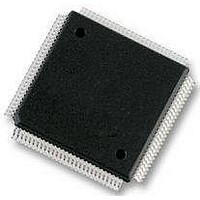S912XEQ384J3CAL Freescale Semiconductor, S912XEQ384J3CAL Datasheet - Page 638

S912XEQ384J3CAL
Manufacturer Part Number
S912XEQ384J3CAL
Description
IC MCU 16BIT 384KB FLASH 112LQFP
Manufacturer
Freescale Semiconductor
Series
HCS12r
Datasheet
1.S912XEQ384J3CAL.pdf
(1328 pages)
Specifications of S912XEQ384J3CAL
Core Processor
HCS12X
Core Size
16-Bit
Speed
50MHz
Connectivity
CAN, EBI/EMI, I²C, IrDA, SCI, SPI
Peripherals
LVD, POR, PWM, WDT
Number Of I /o
91
Program Memory Size
384KB (384K x 8)
Program Memory Type
FLASH
Eeprom Size
4K x 8
Ram Size
24K x 8
Voltage - Supply (vcc/vdd)
1.72 V ~ 5.5 V
Data Converters
A/D 16x12b
Oscillator Type
External
Operating Temperature
-40°C ~ 85°C
Package / Case
112-LQFP
Core
HCS12X
Data Bus Width
16 bit
Data Ram Size
24 KB
Interface Type
SCI, SPI, I2C, CAN
Maximum Clock Frequency
50 MHz
Number Of Programmable I/os
91
Number Of Timers
1
Operating Supply Voltage
3.13 V to 5.5 V
Maximum Operating Temperature
+ 260 C
Mounting Style
SMD/SMT
Lead Free Status / RoHS Status
Lead free / RoHS Compliant
Available stocks
Company
Part Number
Manufacturer
Quantity
Price
Company:
Part Number:
S912XEQ384J3CAL
Manufacturer:
Freescale Semiconductor
Quantity:
10 000
- Current page: 638 of 1328
- Download datasheet (9Mb)
Chapter 16 Freescale’s Scalable Controller Area Network (S12MSCANV3)
16.3.3.1.2
638
Module Base + 0x00X0
Module Base + 0x00X1
ID[10:3]
ID[2:0]
Field
Field
RTR
IDE
7-0
7-5
4
3
Reset:
Reset:
W
W
R
R
Standard Format Identifier — The identifiers consist of 11 bits (ID[10:0]) for the standard format. ID10 is the
most significant bit and is transmitted first on the CAN bus during the arbitration procedure. The priority of an
identifier is defined to be highest for the smallest binary number. See also ID bits in
Standard Format Identifier — The identifiers consist of 11 bits (ID[10:0]) for the standard format. ID10 is the
most significant bit and is transmitted first on the CAN bus during the arbitration procedure. The priority of an
identifier is defined to be highest for the smallest binary number. See also ID bits in
Remote Transmission Request — This flag reflects the status of the Remote Transmission Request bit in the
CAN frame. In the case of a receive buffer, it indicates the status of the received frame and supports the
transmission of an answering frame in software. In the case of a transmit buffer, this flag defines the setting of
the RTR bit to be sent.
0 Data frame
1 Remote frame
ID Extended — This flag indicates whether the extended or standard identifier format is applied in this buffer. In
the case of a receive buffer, the flag is set as received and indicates to the CPU how to process the buffer
identifier registers. In the case of a transmit buffer, the flag indicates to the MSCAN what type of identifier to send.
0 Standard format (11 bit)
1 Extended format (29 bit)
IDR0–IDR3 for Standard Identifier Mapping
ID10
ID2
7
x
7
x
Table 16-31. IDR0 Register Field Descriptions — Standard
Figure 16-30. Identifier Register 0 — Standard Mapping
Figure 16-31. Identifier Register 1 — Standard Mapping
= Unused; always read ‘x’
ID9
ID1
6
x
6
x
Table 16-32. IDR1 Register Field Descriptions
MC9S12XE-Family Reference Manual , Rev. 1.23
ID8
ID0
5
x
5
x
RTR
ID7
4
x
4
x
Description
Description
IDE (=0)
ID6
x
x
3
3
ID5
2
x
2
x
Table
Table
Freescale Semiconductor
ID4
16-32.
16-31.
x
x
1
1
ID3
0
x
0
x
Related parts for S912XEQ384J3CAL
Image
Part Number
Description
Manufacturer
Datasheet
Request
R
Part Number:
Description:
Manufacturer:
Freescale Semiconductor, Inc
Datasheet:
Part Number:
Description:
Manufacturer:
Freescale Semiconductor, Inc
Datasheet:
Part Number:
Description:
Manufacturer:
Freescale Semiconductor, Inc
Datasheet:
Part Number:
Description:
Manufacturer:
Freescale Semiconductor, Inc
Datasheet:
Part Number:
Description:
Manufacturer:
Freescale Semiconductor, Inc
Datasheet:
Part Number:
Description:
Manufacturer:
Freescale Semiconductor, Inc
Datasheet:
Part Number:
Description:
Manufacturer:
Freescale Semiconductor, Inc
Datasheet:
Part Number:
Description:
Manufacturer:
Freescale Semiconductor, Inc
Datasheet:
Part Number:
Description:
Manufacturer:
Freescale Semiconductor, Inc
Datasheet:
Part Number:
Description:
Manufacturer:
Freescale Semiconductor, Inc
Datasheet:
Part Number:
Description:
Manufacturer:
Freescale Semiconductor, Inc
Datasheet:
Part Number:
Description:
Manufacturer:
Freescale Semiconductor, Inc
Datasheet:
Part Number:
Description:
Manufacturer:
Freescale Semiconductor, Inc
Datasheet:
Part Number:
Description:
Manufacturer:
Freescale Semiconductor, Inc
Datasheet:
Part Number:
Description:
Manufacturer:
Freescale Semiconductor, Inc
Datasheet:











